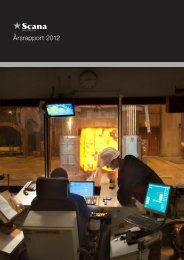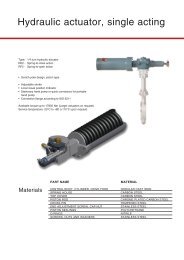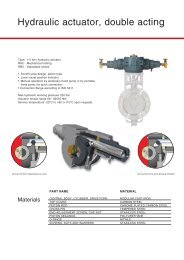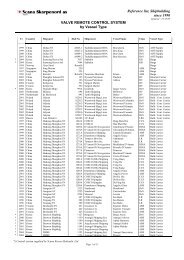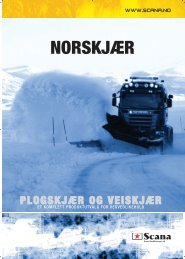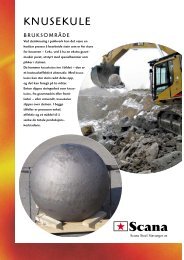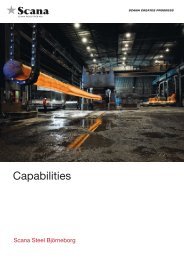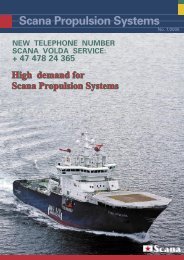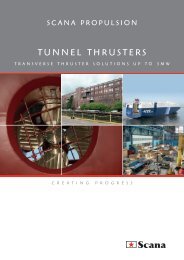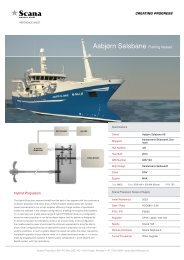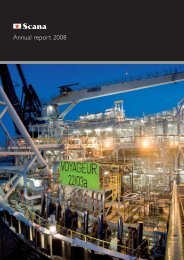Annual Report 2010 - Scana Industrier ASA
Annual Report 2010 - Scana Industrier ASA
Annual Report 2010 - Scana Industrier ASA
You also want an ePaper? Increase the reach of your titles
YUMPU automatically turns print PDFs into web optimized ePapers that Google loves.
53Acquisition cost for tangible fixed assets is the purchase price,including duties/taxes and costs directly linked to rendering the assetusable. Expenses incurred after the asset is commissioned, such asongoing maintenance, are entered in the profit and loss account whileother expenses that are expected to give future economic benefits,including major maintenance work, are entered in the balance sheet.Depreciation is calculated on a straight-line basis over the useful lifeof the assets. The useful life, residual value and depreciation methodof the property, plant and equipment are reviewed annually.Investments and other financial instrumentsFinancial assets in the scope of IAS 39 are classified as eitherfinancial instruments at fair value through the profit and loss account,or as loans or receivables. When financial assets are recognisedinitially, they are measured at fair value, plus, in the case of investmentsnot at fair value through profit or loss, directly attributabletransaction costs. The group determines the classification of itsfinancial assets after initial recognition and, where allowed andappropriate, re-evaluates this designation at the end of each financialyear.<strong>Annual</strong> <strong>Report</strong> <strong>2010</strong> <strong>Scana</strong> <strong>Industrier</strong> <strong>ASA</strong>The book value of property, plant and equipment is reviewed forwrite-down when events or changes in circumstances indicate thatthe book value may not be recoverable.The Group capitalize major periodic maintenance work is depreciatedin line with the periodic maintenance programme.Larger spare parts and back-up equipment are included in property,plant and equipment when they are expected to be utilised over morethan one accounting period. Similarly, if the spare parts and back-upequipment can only be utilised in combination with some property,plant and equipment, they are included in these assets in the balancesheet.Write-down of assetsAn assessment of write-downs on other fixed assets is made whenthere are indications of a fall in value. If an asset’s book value ishigher than the asset’s recoverable amount, the asset will be writtendown via the profit and loss account. The recoverable amount isthe higher of the fair value less sales costs and the utility value(the discounted cash flow from continued use). The fair value lesssales costs is the amount that can be obtained from a sale to anindependent third party minus the sales costs. The recoverableamount is determined separately for all assets but where this is notpossible it is determined together with the cash-generating unit towhich the assets belong.With the exception of the write-down of goodwill, write-downsrecognised in the profit and loss accounts for previous periods arereversed when there is information that the need for the write-downno longer exists. The reversal is recognised in the profit and lossaccount. However, no reversal takes place if the reversal leads to thebook value exceeding what the book value would have been if normaldepreciation had been applied.Deferred tax assetsDeferred tax assets are recognised when it is probable that thegroup will have sufficient tax-related profit in subsequent periods toutilise the tax advantage. The companies recognise previously nonrecogniseddeferred income tax assets to the extent it has becomeprobable that they will be utilised. Similarly, the companies will reducedeferred income tax assets recognised in the balance sheet if it is nolonger considered probable that they will be utilised.Shares in associated companiesAssociated companies are units in which the group has a significantinfluence, but not control (normally with a holding of between 20 and50 per cent), over financial and operational matters. The consolidatedaccounts include the group’s share of the profit from associatedcompanies recorded according to the equity method from the datesignificant influence is established until such influence ceases.When the group’s share of loss exceeds the investment in anassociated company, the group’s book value is reduced to zero, andfurther loss is not entered in the accounts unless the group has anobligation to cover this loss.Other sharesOther investments in shares that are neither subsidiaries norassociated companies are entered in the balance sheet at fair valuewith gains or losses being recognised in the profit and loss account.Loans and receivables are non-derivative financial assets with fixedor variable cash flows that are not quoted in an active market. Suchassets are carried at amortised cost using the effective interestmethod. Gains and losses are recognised in the profit and lossaccount when the loans and receivables are transferred or regardedas lost, as well as through amortisation.InventoryInventory, which comprises purchased goods and own manufacturedproducts, is valued at the lower of purchase/production cost andexpected net realisable value. The net sales value is estimatedat the selling price during ordinary operations, minus estimatedcosts of completion, marketing and distribution. Acquisition cost isdetermined by applying the FIFO method, and includes expensesincurred for the acquisition of goods and costs of bringing thegoods to the present condition and location. Own manufacturedgoods include raw materials, energy, direct labor and a proportion ofoverheads, including maintenance and depreciation.Trade receivablesTrade receivables are normally recognised and carried at originalinvoice amount. Provision for loss is made when there is objectiveevidence that the group will not be able to collect the debt.Financial instrumentsFinancial instruments that are not booked at fair value are reviewed ateach balance sheet date in order to identify any decrease in value.Cash and cash equivalentsCash and short-term deposits in the balance sheet comprise cash inbanks and in hand and short-term deposits with an original maturityof three months or less.For the purpose of the consolidated cash flow statement, cash andcash equivalents consist of cash and cash equivalents as definedabove. The cash flow statement has been prepared using the indirectmethod.Retained assetsBusiness or assets planned for disposal / sale or where adisposal / sale is highly likely are classified as retained assets in thebalance sheet.Share-based remunerationSenior employees in the group are allocated options to buy shares inthe parent company. The options are valued based on their fair valueon the date the option plan was adopted. The options are valued in linewith the Black and Scholes model. The cost of the option is distributedover the period the employees earn the right to receive the options.Own sharesThe group recognise own shares directly against shareholders equityat historical cost.Financial instruments and hedgingThe group uses financial instruments such as forward currencycontracts, interest rate swaps and electricity derivatives to hedge itsrisks associated with interest rate, foreign currency and electricityprice fluctuations. Such financial instruments are initially recognisedat fair value on the date on which a derivative contract is entered intoand are subsequently reassessed at fair value. Derivatives are carriedas assets when the fair value is positive and as liabilities when the fairvalue is negative.



